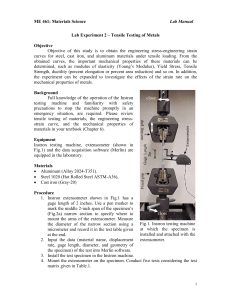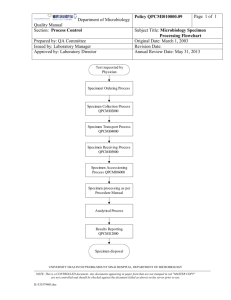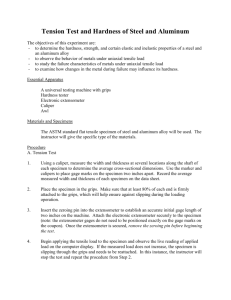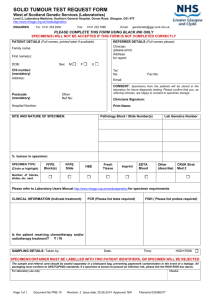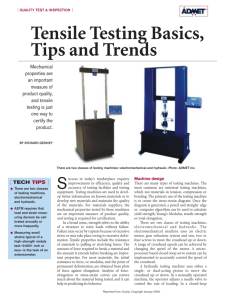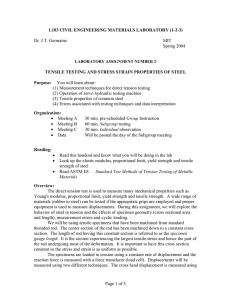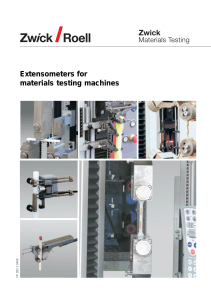uniaxial tension test data sheet
advertisement
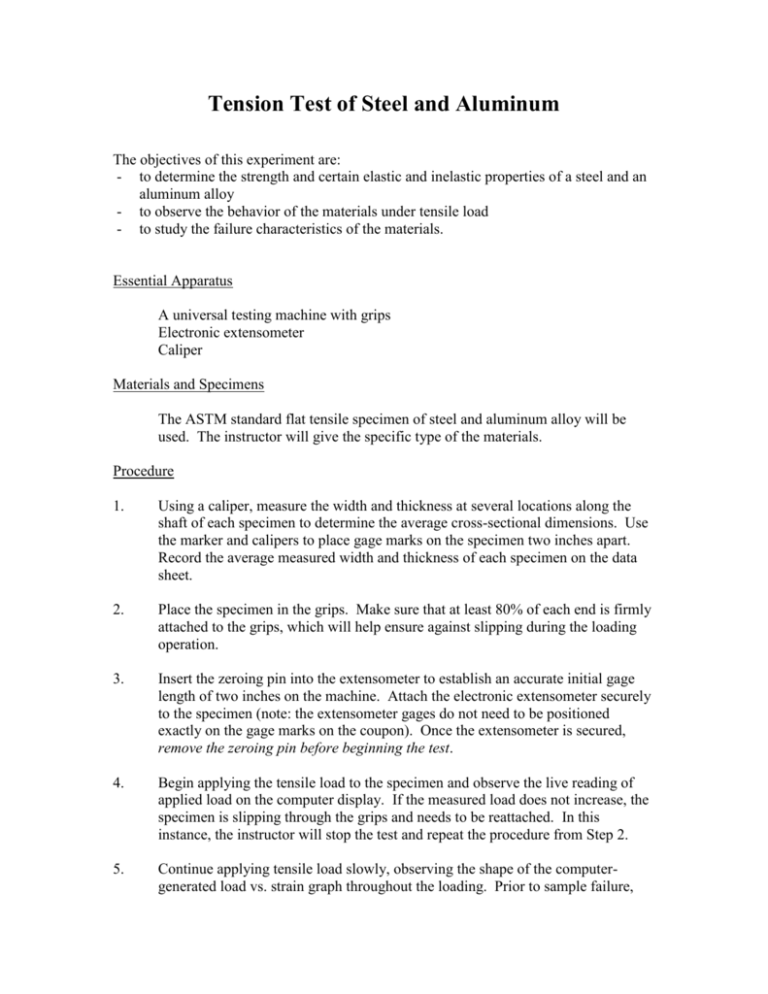
Tension Test of Steel and Aluminum The objectives of this experiment are: - to determine the strength and certain elastic and inelastic properties of a steel and an aluminum alloy - to observe the behavior of the materials under tensile load - to study the failure characteristics of the materials. Essential Apparatus A universal testing machine with grips Electronic extensometer Caliper Materials and Specimens The ASTM standard flat tensile specimen of steel and aluminum alloy will be used. The instructor will give the specific type of the materials. Procedure 1. Using a caliper, measure the width and thickness at several locations along the shaft of each specimen to determine the average cross-sectional dimensions. Use the marker and calipers to place gage marks on the specimen two inches apart. Record the average measured width and thickness of each specimen on the data sheet. 2. Place the specimen in the grips. Make sure that at least 80% of each end is firmly attached to the grips, which will help ensure against slipping during the loading operation. 3. Insert the zeroing pin into the extensometer to establish an accurate initial gage length of two inches on the machine. Attach the electronic extensometer securely to the specimen (note: the extensometer gages do not need to be positioned exactly on the gage marks on the coupon). Once the extensometer is secured, remove the zeroing pin before beginning the test. 4. Begin applying the tensile load to the specimen and observe the live reading of applied load on the computer display. If the measured load does not increase, the specimen is slipping through the grips and needs to be reattached. In this instance, the instructor will stop the test and repeat the procedure from Step 2. 5. Continue applying tensile load slowly, observing the shape of the computergenerated load vs. strain graph throughout the loading. Prior to sample failure, the test will be paused, without unloading the specimen. At this point, remove the extensometer. 6. Resume loading the specimen until failure. Upon reaching the maximum load, the measured loads will begin to decrease (note: the maximum load may occur before the extensometer is removed). At this point, the specimen will begin necking and final fracture should occur within this necked region. Record the maximum load and the load at failure. 7. Remove the broken specimen from the machine. Observe the location and character of the fracture. Fit the broken parts together and measure the final gage length, thickness, and width in the necked region. Record these values on the data sheet. Results Plot two stress-strain diagrams for each material showing - the initial portion of the stress-strain curve up to yield strength, - the entire stress-strain curve. Note that because the extensometer is removed prior to failure, the graph will need to be extended beyond the computer-recorded strain values to include the strain at failure (measured using the calipers). Using the laboratory data and graphs, determine the following material properties: (1) Proportional Limit (2) Upper and Lower Yield Point (3) 0.2% Offset Yield Strength (4) Maximum Tensile Strength (5) Rupture Strength (6) Percent Elongation at Failure (7) Modulus of Elasticity (8) Toughness (9) Type and Character of Fracture (10) True Stress at Failure Some of these properties may not be obtainable for some materials tested. Discussion 1. Compare the measured yield strength and elastic modulus for the metals with typical values. 2. Describe possible sources of error during the test and their effect on data and calculations. 3. Compare the measured properties of the two metals, including strength, ductility, elastic modulus, and toughness. 4. Discuss the difference between Engineering Stress and True Stress and whether there is a significant difference between these values at failure. 5. Explain the necking process, and discuss how the necking of the specimen relates to the shape of the stress-strain curve. 6. Compare the appearance of the fracture surface for each material. Discuss what the failure surface reveals about each material’s behavior under tensile loading. UNIAXIAL TENSION TEST DATA SHEET Material 1: ___________ Gage Length (initial):___________ Thickness (initial):_____________ Width (initial):___________ Cross Sect. Area (initial):_________ Gage Length (final):____________ Thickness (final):______________ Width (final):____________ Cross Sect. Area (final):__________ Maximum Load:_______________ Failure Load:_____________ Material 2: ___________ Gage Length (initial):___________ Thickness (initial):_____________ Width (initial):___________ Cross Sect. Area (initial):_________ Gage Length (final):____________ Thickness (final):______________ Width (final):____________ Cross Sect. Area (final):__________ Maximum Load:_______________ Failure Load:_____________ Instructor’s Signature______________________
